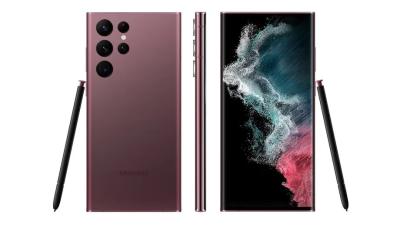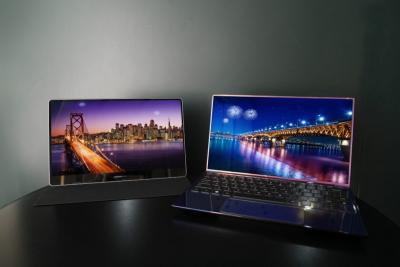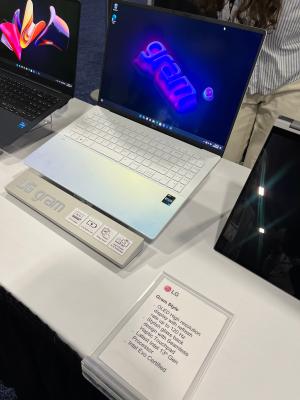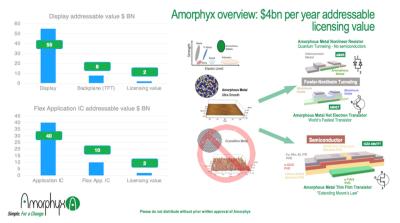Samsung to start shipping its 77" S95C QD-OLED TV next month, for $4,500
Last month Samsung announced its S95C QD-OLED TV, and now the company starts accepting orders for its 77" model - for $4,500. The TVs will ship on March 6.
The S95C offers a 4K resolution, 144Hz refresh rate, Tizen 7 OS, Dolby Atmos, Gaming Hub and an external connector box (One Connect). The peak brightness is "over" 2,000 nits. It will be available in 55", 65" and 77".
Samsungs reports its Q4 2022 financial results, OLED sales declined as demand for smartphones fell
Samsung Electronics reported its financial results for Q4 2022, with revenues of $57.3 billion, and an operating profit of $3.5 billion.

Samsung says that the "business environment deteriorated significantly in the fourth quarter due to weak demand amid a global economic slowdown". SDC's mobile AMOLED panel business earning declined, as demand for smartphones fell, but its large-area panel business seen a smaller loss as it is increasing sales of QD-OLED panels.
UBI: Samsung to increase its QD-OLED capacity by 50% by 2024
UBI Research says that Samsung Display has decided to increase its QD-OLED production capacity, from 30,000 monthly substrate to 45,000 - that's a 50% increase - by 2024.

UBI also says that Samsung has updated its QD-OLED material stack (now called QM2), with an upgraded ETL green layer, and has started to recycle the waste materials in its production process.
LG Electronics is using SDC AMOLEDs in its 2023 Gram laptops
Earlier this month LG Electronics introduced its 2023 Gram laptop series, that all come with OLED displays. According to the latest update from Korea, these new laptops use displays produced by Samsung Display.
This is the first time that Samsung provides AMOLED displays to LG Electronics. These are rigid OLEDs. LG Display does not produce such displays, it is making only flexible OLED panels.
Samsung Display launches new OCTA 120Hz laptop OLED displays
Samsung Display announced that it is beginning to produce touch-enabled OLED displays for the laptop market. These panels will adopt the company's latest OCTA (on-cell touch) technology, and will support a 120Hz refresh rate and will offer a 3K resolution (the company did not detail the size).

Samsung says that the first laptops to adopt the new panels will be Samsung's own 2023 Galaxxy Book notebooks, but the panels will also be offered to other laptop makers.
The Korean Government approves OLEDs as a national strategic technology to encourage more investments
As we reported a few days ago, The Korean government has officially designated five display technologies as "national strategic technologies", which gives tax breaks to display makers and developers.
The five display technologies include three specific display technologies - AMOLED, microLEDs and QD displays, in addition to deposition technologies materials and TFT equipment and materials. As strategic technologies, the government gives generous (30-50%, depending on the company size) tax credits for R&D and 8-16% tax credits for building production lines for materials, equipment or displays. The government is also considering increasing the tax credits for production lines up to 25%.
ETNews: Apple signs contracts to develop tablet and laptop OLEDs, gets ready for the first OLED iPad in 2024
Korea-based ETNews reports that Apple has finally committed to adopt OLED displays in future tablets and laptops, and the company has signed a contact with a "local OLED developer" (which means either Samsung Display or LG Dispaly) to develop four different OLED displays.
According to the report, Apple decided to adopt a 10.86" and 12.9" AMOLED displays for future iPad devices, and 14" and 16" displays for future MacBooks. The first OLED iPad will be released in 2024, while the first OLED MacBook will come later in 2026.
Samsung asks the ITC to ban the import of aftermarket AMOLED smartphone displays into the US
According to reports, Samsung Display has appealed to the US ITC asking to ban aftermarket and refurbished AMOLED displays from entering the US.

Today it is possible to repair a smartphone display and replace the screen - and there are companies (mostly independent outlets) that offer lower cost displays - which could refurbished ones, aftermarket imports - or even lower cost alternatives produced by other makers. If the ITC approves Samsung's request, these will not be available anymore, and only original Samsung AMOLED displays will be allowed.
Samsung introduces new low-blue-light AMOLED displays
Samsung has demonstrated new AMOLED display panels that offer a lower blue-light emission compared to its current low-blue-light AMOLEDs. Samsung says that the new display reduces blue light emission by 70% compared to 'conventional' displays (which probably means LCD displays, not standard AMOLEDs).
Samsung brands these new displays as Gen-2 LBL (low-blue-light) AMOLEDs, and says that the lower blue light emission was achieved by a combination of the latest OLED emitter materials and advanced AI software. Samsung is mostly targeting laptop displays, saying that the new Gen-2 LBL displays can achieve a brightness of up to 2,000 nits. Samsung will start producing Gen-2 LBL AMOLEDs by the end of 2023.
Amorphyx Q&A about champion performance in IGZO TFT for OLED Smartphone applications
This is a sponsored post by Amorphyx, where display industry consultant Ian Hendy has interviewed Amorphyx's CEO John Brewer
Q: Can you start by telling us a little about what Amorphyx does, John?
Amorphyx has several fundamentally new technology platforms that provide for TFT performance improvements in three areas: (1) Switching speeds, with options to move to the Tera-Hz range ultimately, (2) Power, where the IGZO AMeTFT can achieve even lower power performance than today’s LTPO OLED Pro Motion displays and better refresh range, and (3) Small transistor size.
Our technology platforms are lower cost than the alternatives, and move from amorphous and crystalline semiconductor approaches, to devices based on different effects that do not have a semiconductor at all, yet can still drive a display, drive current, deliver grey scale and switch very fast. Or they can operate a flex IC at higher clock speeds than known today.
For now, our main commercial focus is on IGZO AMeTFT which is fundamentally a potential replacement transistor for LTPS or LTPO used in modern OLED phones and has the capability to replace more highly compensated LTPO circuits in modern Smartphone displays due to enhanced stability.
Pagination
- Previous page
- Page 15
- Next page





